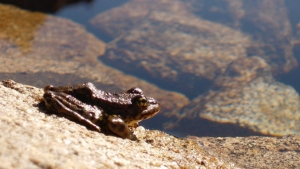Beyond Infection, Fungus Alters Endangered Frog’s Microbiome
Just as beneficial microbes in the human gut can be affected by antibiotics, diet interventions and other disturbances, the microbiomes of other animals can also be upset.
 Healthy-looking frog held by researcher in the field. (Photo credit: Andrea Jani) In a rare study, a researcher with the University of Hawaiʻi at Mānoa School of Ocean and Earth Science and Technology (SOEST), determined the skin microbiome of an endangered frog was altered when the frogs were infected by a specific fungus, and it did not recover to its initial state even when the frog was cured of the infection.
Healthy-looking frog held by researcher in the field. (Photo credit: Andrea Jani) In a rare study, a researcher with the University of Hawaiʻi at Mānoa School of Ocean and Earth Science and Technology (SOEST), determined the skin microbiome of an endangered frog was altered when the frogs were infected by a specific fungus, and it did not recover to its initial state even when the frog was cured of the infection.
All animals host symbiotic microbes—many of which are beneficial—within and on their bodies. For optimal health, this microbial community needs to remain robust and fairly stable, either by resisting change or by recovering effectively after a disruption. Some infectious diseases disrupt the microbiome, but very little is known about what happens after the host is cleared of infection.
Andrea Jani of SOEST, led a team of researchers from the San Francisco Zoological Society, Sequoia and Kings Canyon National Parks, USDA Forest Service and the University of California to study the skin microbiome of the mountain yellow-legged frog (Rana muscosa), an endangered species in the Sierra Nevada mountains in California.
Fungus drives species extinctions
 A photo of the pathogenic fungus, under magnification. (Photo credit: Andrea Jani)
A photo of the pathogenic fungus, under magnification. (Photo credit: Andrea Jani)
 A photo of the pathogenic fungus, under magnification. (Photo credit: Andrea Jani)
A photo of the pathogenic fungus, under magnification. (Photo credit: Andrea Jani)
Batrachochytrium dendrobatidis (Bd) is a fungus that infects the skin of amphibians. Since its discovery just over two decades ago, Bd has emerged as a global threat to amphibians. This pathogen has affected hundreds of species and driven massive population declines, including 90 presumed species extinctions—representing the greatest known disease-induced biodiversity loss. The mountain yellow-legged frog is one such species threatened by Bd.
“Many populations of these frogs have been wiped out by Bd infection, and the fate of remaining populations will depend largely on their ability to survive despite the presence of the pathogen,” said Jani.
Attempts to protect frogs
Jani’s collaborators have been testing immunization as a method to protect these frogs. Frogs are taken into captivity, deliberately infected with the pathogen, and then cleared of their infections using antifungal drugs, in an attempt to train their immune systems to recognize and fight the pathogen. The frogs are then released back to the wild.
During one of these trials, Jani and her collaborators sampled the skin microbiomes of the frogs before they were exposed to the pathogen, after they were infected, and again after they had been cleared of infection. She then used genetic sequencing technologies to identify the bacteria present.
 Healthy-looking frog in Sierra Nevada, California. (Photo credit: Andrea Jani)
Healthy-looking frog in Sierra Nevada, California. (Photo credit: Andrea Jani)
“We found that Bd infection disturbed the frog microbiome by altering the relative abundances of core bacterial species, just as we had observed in previous research,” said Jani. “But surprisingly, when the frogs were cleared of their infections, their microbiomes did not recover. In other words, removing the cause of the microbiome disturbance was not enough to bring about recovery from the disturbance.”
With a wide variety of microbiome research being conducted in Hawaiʻi, the UH Mānoa Center for Microbiome Analysis through Island Knowledge and Investigation connects microbiome scientists, including Jani, across the islands, furthering collaboration and facilitating new discoveries related to environmental and human health.
This research is an example of UH Mānoa’s goal of Excellence in Research: Advancing the Research and Creative Work Enterprise (PDF), one of four goals identified in the 2015–25 Strategic Plan (PDF), updated in December 2020.
For more information, see SOEST’s website.
–By Marcie Grabowski
Publication: Jani, A.J., et al. The amphibian microbiome exhibits poor resilience following pathogen-induced disturbance. The ISME Journal, (2023). DOI:10.1038/s41396-020-00875-w
Original Story Source: University of Hawaii at Manoa

 Alerts Sign-up
Alerts Sign-up